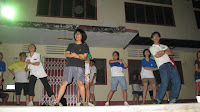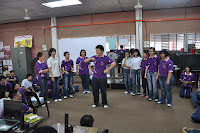保卫黄河:
毛主席曾说中国革命市场出来的,而《保卫黄河》因具有广泛的群众性,成了抗日军民广为传播的一首歌曲。全曲采用了进行曲体裁、以短促跳 动、振奋人心的音调、响亮的战斗口号、铿锵有力的节奏,以快速大跳的动机和逐步扩张的音型,使歌曲充满力量的感情,形象地刻画了游击健儿端起土枪洋枪、挥 动大刀长矛,在青纱帐里、万山丛中,为保卫黄河、保卫全中国而战斗的壮丽场景。
通过弹拨乐的呈现,使歌曲显得明快、豪放,并具有浓厚的民族风格。 这首歌曲巧妙地隐喻了抗日武装队伍,由弱到强,终于汇成了一支不可战胜的力量,也显示了英雄民族的伟大气魄。
Protect the Yellow River is the 3rd movement from the Yellow River Cantata and Concerto by Xian XingHai (1905 – 1945), a well known composer for patriotic songs during the Cultural Revolution and the invasion of the Japanese army.
The piece played by the Catholic High School Chinese Orchestra is specially edited from its original piano concerto to suite the orchestra. The bold, strong and agitated character of this piece depicts young warriors of the nation firing arms in battlefields and rough mountainous terrain to fend for their country.
The slower and broadening section of this piece sounds the people’s sentiment towards Chairman Mao, glorifying him in the lyrics of the Yellow River Cantata.
红 娘子 - 剑舞:
北方汉族民间舞蹈,全曲以剑术的英武动作、韵律的优美,呈现出有搏击和抒情的气氛。杜甫描绘此舞:“燿如羿射九日落,矫如群帝骖 龙翔。来如雷霆收震怒,罢如江海凝清光。”
剑舞舞姿潇洒英武,形式绚丽多彩,从动作变化上看,大体可分为“站剑”和“行剑”两大类。“站剑”动作 迅速敏捷,静止时姿态沉稳利爽,富有雕塑感;“行剑”动作连绵不断,如长虹游龙,首尾相继,又如行云流水,均匀而有韧性。
Hong Niang Zi is a Peking opera series whereby the Sword Dance is an episode. Heavily influenced by the style of the Peking Opera, this song imitates the slang and intonation of the opera singers while picturing the movements of the sword dance.
The moves of the sword dance are mainly ‘ZhanJian’(Standing Sword) and ‘XingJiang’(Moving Sword). The moves of the Standing Sword are sharp and vigorous with abrupt pauses with a pose at the end of the phrase by the dancers whereas the Moving Sword moves are continuous and even yet persistent.
渔舟凯歌:
《渔舟凯 歌》是一首鼓乐合奏。这首歌描述渔夫们在大海中捞获大量的收获。《渔舟凯歌》叙述渔夫刚出海时平静的风景,再加上朵朵的浪花随着起舞。它充分发挥了舟山锣 复杂的演奏技巧,表达出人们忘我劳动的热情,最后又以舟山锣的高难度快速演奏作结束,有着极强烈的艺术效果。
The Jubilant Song of a FisherBoat is a percussion ensemble. It narrates a prosperous catch by fishermen fishing at deep sea.
The exposition portrays fishermen hard at work to set sail before the first beam of light penetrates the clouds.
The song develops into a calm mood when the fisherboat is anchored at deep sea, swaying with the waves. The scene of the vast sea that stretches far beyond the horizons is heard through the YunLuo.
As the fishermen haul in their catch, the song gently recapitulates, ending with the fishermen returning home in jubilant moods with their harvest.
拉萨行:
《拉萨行》是一首藏族风情的乐曲, 是关迺忠创作的一首四个乐章的民族管弦乐组曲。乐曲共分为四个乐章:布达拉宫、雅魯藏布江、天葬、打鬼。作曲家运用现代意识的复合节奏型混奏,渲染出這一 火热而又神秘的气氛,当中亦有前三个乐章的主題隐现,以表现人们还在紧守着传统的灵念,最后乐队掀起狂热的高潮在祈福的热切中结束。
A Tour to Lhasa is a song written by a Guan Nai Zhong, a composer foreign to the land of Lhasa in Tibet. There are four movements to this piece: Potola Palace, Yarlung Zangbo River, Heavenly Burial and Beating Ghost. Guan Nai Zhong used the New Music approach to picture Lhasa, with clashing and opposing rhythms creating a fiery yet mysterious atmosphere. The theme of this song is conveyed in three of the movements, portraying the strongly inherited beliefs of the people in Lhasa.
• 第一乐章 “布达拉宫”
怀着虔诚的心,朝圣者向着布达拉宫匍匐前进。啊!布达拉宫高高伫立在玛布山上, 层叠的宫宇映照着蓝天白云,是那么的伟大,神圣。一步一趋,宏伟的布达拉宫就在眼前了,神秘的号角声一阵阵传来,朝圣者满怀敬意,就快可以进寺膜拜祈愿 了!
The pilgrim makes his way towards Potala Palace with sincerity. Ah, how grand and godly the palace stood! Situated on the Mabu hill, the towers of the palace reflects the blue sky and its white, whispy clouds. With every step the pilgrim takes, the magnificent palace grows larger. When a mysterious bare of a horn radiates from within the palace, the pilgrim’s heart filled with pleasure: he will soon be able to fulfill his pilgrimage!
• 第二乐章 “雅鲁藏布江”
雅鲁藏布江,她是藏民的母河。高山的融雪, 汇集成河,奔腾在宽广的原野,藏人依偎着它生活。它源远流长,滋润着草原,滋润着藏民的心。
Yarlong Zanbo river is the heartbeat of the Tibetan’s life which originates from the melted snow of the Himalaya ranges. It started off in trickling streams, later expanding into a river which flows swiftly through lush green meadows. Yarlong Zanbo river flows far and wide, giving life to the grass of the meadows and bringing comfort and nourishment to the hearts of the people.
• 第三乐章 “天葬”
裹着白布的死者被送上了半山腰中的天葬台,山风呼呼地撕扯着四周的经幡,和着喇嘛 们低低的吟咏声。秃鹰闻讯而来,在空中盘旋着,虎视眈眈。天葬师麻利将尸体肢解切块,把骨头捣碎,完后点燃一旁的桑烟。青烟穿上了天空,秃凰纷纷闪动着翅 膀扑向天葬台,争食着骨团和肉块。死者的魂魄也随着被尸身食尽无遗而得到了升华,渐渐得升上了天空。
The deceased is wrapped in a white cloth and sent halfway up a mountain, where the funeral parlour is. The mountain wind howls loudly, accompanied by the soft chanting of the Lhamas (high priests). A bald eagle soars past, circling the air above the funeral procession, eyeing the carcasses with its piercing glare. The eagles snatched and fought for the bones and meat of the carcass. It is the belief of the Tibetans, that when the carcass of a deceased had been completely feasted upon, the soul of the deceased rises, slowly into the air, high above the clouds.
• 第四乐章 “打鬼”(宗教/习俗)
跳布扎,俗称‘打鬼’。农历正月末,一年一度的跳布扎拉开了序幕。头戴各种神,兽面具的喇嘛们,扬手,提足地 环绕表演场地,各路神灵降临人间了!一组组具有专题内容的舞蹈陆续出场,有地狱小精灵们相互戏耍的 ‘骷髅舞’,为人间带来福禄,活泼可爱的‘鹿神舞’等。震撼人心的乐曲交织着信徒们的欢呼声,真是热闹无比。仪式在降伏恶鬼下顺利落幕,信徒们伏地叩拜迎 来人间祥和与福顺。
Beating Ghost is an annual ritual performed by Lhamas at the end of the first lunar month. The Lhamas encircle the performing area in a dance with masks that represents the different gods, symbolizing the arrival of those gods to mingle among the people. The festive air is filled with songs of worship, mingled with the clatter and cheer of the people’s merry-making. The downfall of the Devil marks the end of this ritual, whereby followers kneeled to embrace peace and blessings.
一只鸟仔:
《一只鸟仔》是流传在台湾的一首儿歌。在两段歌词中,每段都采用了象声词来形容一种小动 物 的鸣叫声和神态,使得歌曲颇为生动有趣。歌曲为五声徽调式。音域在九度以内。全曲共四乐句,每句四小结。曲式属于典型的“起承转合”。全曲统一、完美、形 象的表现了孩子们天真、可爱和纯洁的性格。
A Little Bird is a folk song in Taiwan. Its lyrics imitate the chirps and voice the little movements of a small bird, sounding a light piece with much character.
Build on a pentatonic base in even time, this structural piece consists of four 4 bar phrases. It is written in the typical format of A, A’, B, A which starts with the exposition, transits into the development and then the variation, ending with a recapitulation of the first section. Although this piece lies within the range of a compound 2nd, it is complete and sufficient to depict the carefree, delightful nature of children.
骏 马奔驰
《骏马奔驰》是大型民族器乐合奏组曲《祖国处处是春天》的一个乐章。《骏马奔驰》则是其中着力描写春天赛马季节牧民们骑马驰聘草原的乐曲。 它旋律流畅动听, 节奏灵活多变,作者运用乐队合奏的各种表现手段,刻画草原人民勇敢矫健的英雄形象,表达了人们奔向祖国美好未来的坚强信念和决心。
"The Horse" is a movement in the "Spring is Everywhere in my Motherland" Suite. "The Horse" describes the nomad’s horse racing season throughout the grasslands in spring.
The theme melody is varied by different rhythms and changing keys throughout the song. Through this piece, the composer carved heroic images of the people living in the grasslands, reflecting their determination in paving the country’s future.
The Lord of the Dance:
Lord of the dance 的故事基于一个古老的爱尔兰传说, 赤裸裸而真实地呈现人性黑暗与光明的斗争:为了权势、爱情、欲望, 黑暗之王挑战正义之王和他的属民。一场狂野斗争即将展 开; 两个女人的爱情争夺即将展开。舞蹈就是武器、舞蹈就是力量,整场演出充满顿挫起伏的肢体,语汇与戏剧张力,将爱尔兰舞蹈带入前所未有的空前高度,赋予 观众们一次次珍贵而奇妙的经历。
This version of The Lord of the Dance is a program music for an Irish Legend based story.
It has the theme of battle between good and evil in man. The King of Darkness challenges the King of Justice and his people in a battle for power, love and dreams. A wild battle broke out between two women competing for love, whereby dance, is their weapon and their power. The entire performance is full of ups and downs and drama bringing Irish dancing to greater heights. In this performance, the audience is given a rare and wonderful experience with just the song of the dance.
Fantasy Dance:
Fantasy dance (Song Notes by composer Chew Hee-chiat)
Compelled by the desire to share the unique diversified culture of Malaysia with the rest of the world, I decided to compose Fantasy Dance for PCCO's concert tour to Hong Kong in December 1999.
Inspired by the rhythm of the rebana, one type of ethnic Malay drums, I began to fantasize a dance - of the colorful and exotic Malay culture. Fantasy Dance uses many "augmented seconds", also known as the "Arabian interval" to symbolize Arabian and Islamic influence on Malay music. Rebana and knobbed gong are used to add more "exotic flavour".
Although Fantasy Dance was initially set to emulate Malay culture, I discovered a slightly different result, i.e. Islamic and Arabian influences are more prominent that that of local Malay's. In all cases, Fantasy Dance is my attempt to lure more in-depth cultural interaction among diversified cultures.
幻 想舞曲
作曲家为了向外国朋友展示马来西亚的独特多元,创作了这首《幻想舞曲》,并在1999年香港之旅中演 出。
从一种马来民族 雷班纳鼓的动人节奏中,周氏幻想了一个舞蹈 -- 一个充满马来亚色彩和异域情调及异于传统中乐的舞蹈音乐。它应用许多增二度音程,亦称之为阿拉伯音程来象征着阿拉伯和回教文化对马来音乐的影响。雷班纳古 和凸锣的应用更添加了异曲的风味。
虽然创作《幻想舞曲》的原意是竭力效仿马来原意风采,但结果却出人意料,曲子演奏出来的效果显示出阿 拉 伯和回教的曲风远远超过马来本土风格。无论如何,这首作品是第一次的尝试,希望能诱发更深的多样文化交流。







































































